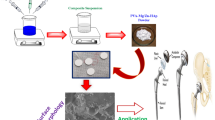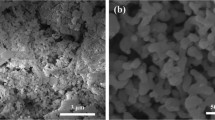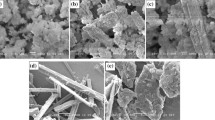Abstract
Generally, the coating properties of polymeric compounds are enhanced by using nanomaterials as fillers which are non-biobased. In this project, the hydroxyapatite (HAP) was obtained from waste fish scales and the biobased hyperbranched polyol (HyBP) was synthesized from castor oil. The series of nanocomposites were prepared by adding various amounts of HAP (0.5% wt, 1% wt, and 2% wt) in HyBP along with isophorone diisocyanate (IPDI) (maintaining the NCO:OH, ratio at 1.2:1). These mixtures were coated on mild steel panels and glass plates. The synthesized HyBP was characterized by FTIR, 1HNMR, and 13CNMR techniques. The HAP was characterized by FTIR, FESEM, and XRD techniques. The surface morphology of prepared nanocomposites was studied by FESEM, XRD, and AFM techniques. The nanoparticle size was determined by TEM technique. The thermal behavior of nanocomposites was studied by TGA technique. The coating properties were determined by impact strength, crosscut adhesion, and flexibility test. The corrosion properties of the coatings were determined by the immersion test as well as electrochemical test.
Graphic Abstract














Similar content being viewed by others

References
Zheng Y, Li S, Weng Z, Gao C (2015) Hyperbranched polymers: advances from synthesis to applications. Chem Soc Rev 44(12):4091–4130
Van Benthem RATM (2000) Novel hyperbranched resins for coating applications. Prog Org Coatings 40:1–4
Patil AM, Jirimali HD, Gite VV, Jagtap RN (2020) Synthesis and performance of bio-based hyperbranched polyol in polyurethane coatings. Prog Org Coatings 149:105895
Voit B (2000) New developments in hyperbranched polymers. J Polym Sci Part A 38(14):2505–2525
Voit B (2005) Hyperbranched polymers - all problems solved after 15 years of research? J Polym Sci Part A 43(13):2679–2699
Kumar R, Narayan R, Aminabhavi TM, Raju KVSN (2014) “Nitrogen rich hyperbranched polyol via A3 + B3polycondensation: thermal, mechanical, anti-corrosive and antimicrobial properties of poly (urethane-urea). J Polym Res 21:9
Zamboulis A et al (2019) Polyglycerol hyperbranched polyesters: synthesis, properties and pharmaceutical and biomedical applications. Int J Mol Sci 20:24
Loh KP, Lu J, Yang JX, Wang JZ, Lim AL, Wang S (2009) One-pot synthesis of fluorescent carbon nanoribbons, nanoparticles, and graphene by the exfoliation of graphite in ionic liquids. ACS Nano 3(8):2367–2375
Stankovich RR, Dikin S, Dommett DA, Kohlhaas GH, Zimney KM, Stach EJ, Piner EA, Nguyen RD (2006) Graphene-based composite materials. Nature 442(20):282–286
Chattopadhyay DK, Webster DC (2009) Thermal stability and flame retardancy of polyurethanes. Prog Polym Sci 34(10):1068–1133
Fogelström L, Malmström E, Johansson M, Hult A (2010) Hard and flexible nanocomposite coatings using nanoclay-filled hyperbranched polymers. ACS Appl Mater Interfaces 2(6):1679–1684
Das G, Karak N (2009) Vegetable oil-based flame retardant epoxy/clay nanocomposites. Polym Degrad Stab 94(11):1948–1954
Haq M, Burgueno M, Mohanty R, Misra (2011) Bio-based polymer nanocomposites from UPE/EML blends and nanoclay: development, experimental characterization and limits to synergistic performance. Compos A 42(1):41–49
Konwar U, Karak N (2011) Hyperbranched polyether core containing vegetable oil-modified polyester and its clay nanocomposites. Polym J 43(6):565–576
Naik RB, Naik R (2015) Synthesis of silver nanoparticles embedded novel hyperbranched urethane alkyd-based nanocomposite for high solid antimicrobial coating application. J Coatings Techno 12(6):1073–1083
Ma XY, Zhang WD (2009) Effects of flower-like ZnO nanowhiskers on the mechanical, thermal and antibacterial properties of waterborne polyurethane. Polym Degrad Stab 94(7):1103–1109
Atef El-Sayed A, El LK, Gabry, Allam OG (2010) Application of prepared waterborne polyurethane extended with chitosan to impart antibacterial properties to acrylic fabrics. J Mater Sci Mater Med 21(2):507–514
Szcześ A, Hołysz L, Chibowski E (2017) Synthesis of hydroxyapatite for biomedical applications. Adv Colloid Interface Sci 249:321–330
Barakat NAM et al (2008) Physiochemical characterizations of hydroxyapatite extracted from bovine bones by three different methods: extraction of biologically desirable HAp. Mater Sci Eng C 28(8):1381–1387
He Q, Pan L, Wang Y, Meldrum FC (2015) Bioinspired synthesis of large-pore, mesoporous hydroxyapatite nanocrystals for the controlled release of large pharmaceutics. Cryst Growth Des 15(2):723–731
De B, Gupta K, Mandal M, Karak N (2014) Biodegradable hyperbranched epoxy from castor oil-based hyperbranched polyester polyol. ACS Sustain Chem Eng 2(3):445–453
Gaikwad MS, Gite VV, Mahulikar PP, Hundiwale DG, Yemul OS (2015) Eco-friendly polyurethane coatings from cottonseed and karanja oil. Prog Org Coatings 86:164–172
Jirimali HD et al (2018) Waste eggshell-derived calcium oxide and nanohydroxyapatite biomaterials for the preparation of LLDPE polymer nanocomposite and their thermomechanical study. Polymer 57(8):804–811
Chaudhari BC et al (2019) Waste eggshells for the decoration of carbon nanotubes and graphene nanosheets with hydroxyapatite for preparation of LLDPE nanocomposites. J Polym Environ 27(11):2352–2359
ASTM Committee D-1 (1987) Standard test method for acid value of fatty acids and polymerized fatty acids. 11:426–427
ASTM (2001) Standard test method for hydroxyl value of fatty oils and acids. Alcohol 86:1–3
Nimeroff I, Hammond HK, Richmond JC, Crandall JR (1956) Specular-gloss measurement of ceramic materials. J Am Ceram Soc 39(3):103–109
S. T. Methods (2001) ASTM D 522: Standard test methods for mandrel bend test of attached organic coatings. ASTM Int, no. Reapproved, pp 1–4
ASTM International (2010) Standard Test Method for Film Hardness by Pencil Test 1. ASTM D3363–05 Stand, 05, no. Reapproved 2011, pp 5–7
Products RC, Applica E, Tape S, Paint T (2002) ASTM D 3359: standard test methods for measuring adhesion by tape test (test method B). ASTM Int, pp 1–7
ASTM D2794 (1993) Standard test method for resistance of organic coatings to the effects of rapid deformation (impact). Astm D794, vol. 93, no. Reapproved, pp 1–3
Fornof AR, Glass TE, Long TE (2006) Degree of branching of highly branched polyurethanes synthesized via the Oligomeric A2 Plus B3 methodology. Macromol Chem Phys 207(14):1197–1206
Halter D, Burgath A, Frey H (1997) Degree of branching in hyperbranched polymers. Acta Polym 48(1–2):30–35
Chaudhari AB, Tatiya PD, Hedaoo RK, Kulkarni RD, Gite VV (2013) Polyurethane prepared from neem oil polyesteramides for self-healing anticorrosive coatings. Ind Eng Chem Res 52(30):10189–10197
Alagi P et al (2018) Functional soybean oil-based polyols as sustainable feedstocks for polyurethane coatings. Ind Crops Prod 113:249–258
Acknowledgements
The authors would like to acknowledge to University Institute of Chemical Technology (UICT) Kavayitri Bahinabai Chaudhari North Maharashtra University, Jalgaon, (M.S.) 425001 for providing AFM results.
Author information
Authors and Affiliations
Corresponding authors
Additional information
Publisher’s Note
Springer Nature remains neutral with regard to jurisdictional claims in published maps and institutional affiliations.
Rights and permissions
About this article
Cite this article
Patil, A.M., Gite, V.V., Jirimali, H.D. et al. Fully Biobased Nanocomposites of Hyperbranched-Polyol and Hydroxyapatite in Coating Applications. J Polym Environ 29, 799–810 (2021). https://doi.org/10.1007/s10924-020-01903-8
Accepted:
Published:
Issue Date:
DOI: https://doi.org/10.1007/s10924-020-01903-8



